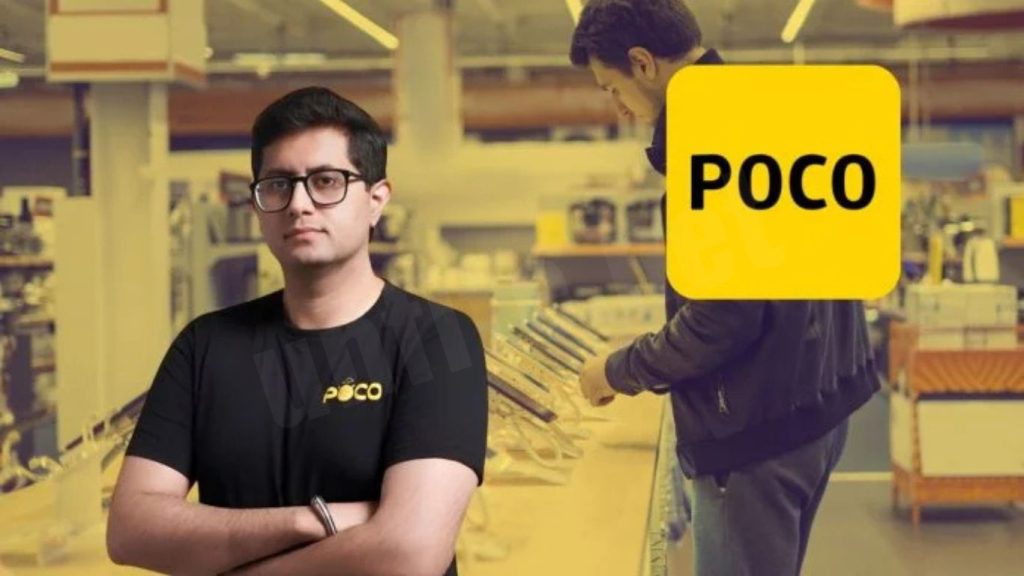Poco Plans to Boost Offline Presence in India and Achieve Double-Digit Growth by 2025 – Report

India is home to many leading tech brands, one of the most prominent being Xiaomi. Xiaomi is recognized for its performance and robust security. A notable sub-brand of Xiaomi is Poco, which recently shared exciting news in India.
Poco smartphones are highly popular in India and known for their impressive features and performance. However, Poco has primarily focused on online sales and has a limited offline presence.
Recently, Poco announced its plans to expand its offline presence across India and capture a larger share of the market.
In this article, we’ll discuss Poco’s strategies for enhancing its offline presence in India and its ambitions to enter the country’s five smartphone markets.
Poco steps for Expansion in India.
In an interview with ET Telecom, Himanshu TandoTandon Highlighted the brand’s successful marketing efforts in India. In 2024, Poco launched exceptional smartphones and achieved impressive sales. However, Tandon expressed his vision for Poco to grow into an even larger brand by 2025.
He revealed that Poco plans to expand its reach by entering the offline market, making its phones more readily available in stores. This move is expected to significantly boost Poco’s, potentially doubling them.
Tandon’s statements in the interview nearly confirmed the strategic shift towards the offline market by 2025.
Why does Poco Want to come into the offline market?

Poco has primarily focused on online channels. However, with increasing competition in the smartphone market and rising consumer demand, the company is now planning to expand its offline presence.
Poco aims to make its products available in key cities and rural areas across India by the end of 2024. To achieve this, the company has partnered with various distributors and retailers.
Poco’s strategy is to reach a broader customer base through offline sales, targeting consumers who prefer shopping in physical stores over online platforms.
Will Poco be able to double its sales in 2025?
The Indian smartphone market is experiencing steady growth, driven by rising demand in rural areas, the expansion of 5G services, and the availability of affordable devices.
Poco is strategically positioning itself to capitalize on these opportunities and strengthen its market share. By offering smartphones that meet the diverse needs of Indian consumers while remaining budget-friendly, Poco is well poised to double its offline presence by 2025.
Why Indians Choose Poco?
India is a vast tech market where some of the world’s largest companies manufacture and export smartphones. Indian consumers are also major buyers of smartphones.
Poco has earned the trust of Indian users. As a sub-brand of Xiaomi, which has a strong connection with Indian consumers, Poco designs smartphones that cater to the needs and preferences of the Indian market, earning widespread appreciation.
Indians are always looking for affordable yet durable smartphones, and Poco consistently delivers on this demand. This is one key reason why Indian consumers love Poco smartphones.
Poco’s Strategy to Expand Offline Presence in IndiPoco’s
Poco’s Shift from Online to Offline Sales
Poco, a popular smartphone brand in India, has primarily relied on online sales channels to reach its customers. However, recognizing the evolving needs of the market and the growing competition, Poco is now shifting its focus towards expanding its offline presence. By diversifying its sales strategy, Poco aims to cater to a broader audience, especially in regions where consumers prefer in-store purchases over online shopping. This shift allows the brand to tap into new markets, increase its visibility, and offer a more personalized customer experience, which is essential for long-term success.
Importance of Physical Availability in Key Markets
The physical availability of Poco smartphones in major cities and rural areas is critical to its growth strategy. AIndia’s’s smartphone market continues to expand, particularly in rural regions, having a strong offline presence ensures that Poco can reach consumers who may not be comfortable with online shopping or lack access to reliable internet services. Physical stores also provide an opportunity for consumers to experience the products firsthand, which can drive purchasing decisions. By making its phones available in key markets, Poco aims to boost brand loyalty, increase sales, and strengthen its market position, ultimately supporting its goal of achieving double-digit growth by 2025.
Reasons BehiBehinPoco’sline Expansion
Growing Smartphone Demand in Rural and Urban Areas
The demand for smartphones in both rural and urban India is rapidly increasing. While urban areas continue to drive the bulk of smartphone sales due to higher disposable incomes and internet penetration, rural regions are emerging as a significant growth area. The rising need for connectivity, access to digital services, and the affordability of smartphones are pushing the demand in these underserved markets. By strengthening its offline presence, Poco can cater to this growing segment, ensuring that its smartphones are accessible to a broader customer base across urban and rural areas.
Expanding 5G Connectivity and Affordable Devices
The expansion of 5G networks across India is creating new opportunities for smartphone brands to engage consumers with faster internet speeds and enhanced digital experiences. Poco plans to leverage this growing infrastructure by offering affordable 5G-enabled devices, ensuring that consumers in both urban and rural areas can access the latest technology without breaking the bank. As more regions gain 5G connconnectivity’s’sategy of providing budget-friendly yet feature-rich smartphones will make it an attractive choice for consumers seeking high-performance devices at competitive prices.
Reaching Untapped Consumer SegmentIndia’s
India’s diverse population includes several untapped consumer segments, particularly in rural areas, where smartphone penetration is still growing. Many consumers in these regions prioritize value-for-money products, durability, and after-sales support, which aligns with Poco’s rings. By expanding its offline presence, Poco can establish stronger connections with these segments, building trust and driving sales. Additionally, reaching out to first-time smartphone buyers and those transitioning from feature phones to smartphones will open new growth avenues. Its affordability, quality, and localized products position it well to penetrate these underserved markets.
Partnerships and Collaborations for Offline SalePoco’s
Poco’s Collaborations with Distributors and Retailers
To strengthen its offline presence, Poco has forged strategic collaborations with key distributors and retailers across India. These partnerships are essential for expanding the availability of Poco smartphones in both urban and rural markets. By working closely with local distributors and retail chains, Poco can ensure that its products are readily available in physical stores, making it easier for customers to access and purchase smartphones. These collaborations also provide Poco with valuable insights into regional consumer preferences, enabling the brand to tailor its offerings and enhance its marketing efforts in different areas.
Enhancing Product Accessibility Across IndiPoco’s
Poco’s goal is to make its smartphones accessible to a broader audience across the country. Through its partnerships with distributors and retailers, Poco is enhancing the accessibility of its products in key markets, ensuring that consumers in both metropolitan cities and smaller towns can easily find and purchase its devices. By increasing its presence in retail stores and expanding the distribution network, Poco aims to overcome geographical barriers and provide customers with greater convenience. This approach not only boosts sales but also helps build brand visibility and loyalty, positioning Poco as a trusted brand in the Indian smartphone market.
Targeting Key Cities and Rural Areas

Focus on Expanding in Major Indian CitiePoco’s
Poco’s strategy for expanding its offline presence includes a strong focus on major Indian cities, where smartphone demand is consistently high. These urban areas offer a large customer base, with tech-savvy consumers who seek high-quality devices at competitive prices. By increasing the availability of Poco smartphones in physical stores across metropolitan cities, the brand aims to enhance its market visibility and provide a direct, in-store experience for potential buyers. Expanding in these cities also allows Poco to tap into a more diverse consumer base, from young professionals to digital enthusiasts, driving both sales and brand recognition in key markets.
Reaching Rural Areas with Affordable Smartphones
In addition to focusing on urban areas, Poco is also prioritizing the expansion of its reach in India’s Regional regions. With a large portion of the population in rural areas still transitioning to smartphones, Poco sees this as a crucial growth opportunity. By offering affordable smartphones that cater to the specific needs of rural consumers—such as durability, long battery life, and ease of use—Poco aims to make its devices more accessible to this segment. Expanding into these areas not only helps Poco capture untapped markets but also addresses the demand for budget-friendly yet reliable smartphones. This dual focus on both urban and rural expansion positions Poco to establish a stronger foothold across India.
Frequently Asked Question
Why is Poco expanding its offline presence in India?
Poco is expanding its offline presence to reach a broader customer base, especially in rural and underserved areas where online shopping is not as prevalent. This move will enhance product accessibility and drive sales, helping Poco achieve double-digit growth by 2025.
When does Poco plan to increase its offline presence in India?
Poco plans to significantly increase its offline presence by the end of 2024, ensuring that its smartphones are available in key urban and rural locations across the country.
What are India’s plans for 2025?
Poco aims to achieve double-digit growth in India by 2025, driven by its expanded offline sales strategy, increased product availability, and a strong focus on consumer needs.
How will PowillPoco’sine expansion impact its market share in India?
By expanding into offline retail channels, Poco hopes to capture a larger share of the Indian smartphone market, particularly among consumers who prefer in-store shopping or lack reliable internet access.
Which cities and regions will Poco target with its offline expansion?
Poco plans to expand its offline presence in major Indian cities and reach underserved rural areas. Smartphone demand is growing, but physical availability is limited.
What types of smartphones will Poco offer in offline markets?
Poco will continue to offer its range of affordable, high-performance smartphones, which appeal to both urban and rural consumers. These smartphones focus on durability, long battery life, and value for money.
Why is Poco focusing on rural markets for offline expansion?
Rural markets in India present significant growth opportunities as more people transition from feature phones to smartphones. Poco aims to make its devices accessible to these consumers through affordable pricing and physical retail availability.
Conclusion
Poco’s strategic move to expand its offline presence in India marks a significant shift in its approach to growth. By increasing the availability of its smartphones in both urban and rural markets, Poco aims to cater to a broader range of consumers who prefer in-store shopping or have limited access to online platforms. With a focus on affordability, quality, and accessibility, Poco is well-positioned to capture the attention of budget-conscious consumers and strengthen its market position.
This offline expansion, combined with its strong online presence, will be crucial to achieving double-digit growth by 2025. As the Indian smartphone market continues to evolve, Poco’s innovation and customer satisfaction will likely help it remain competitive and maintain its status across the country.




